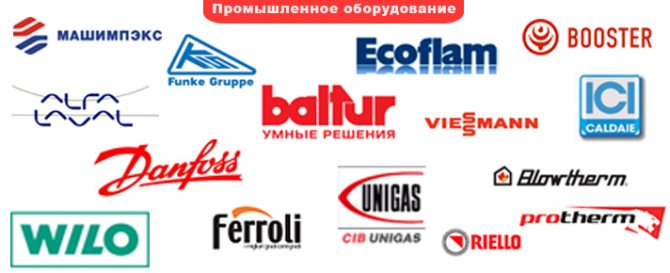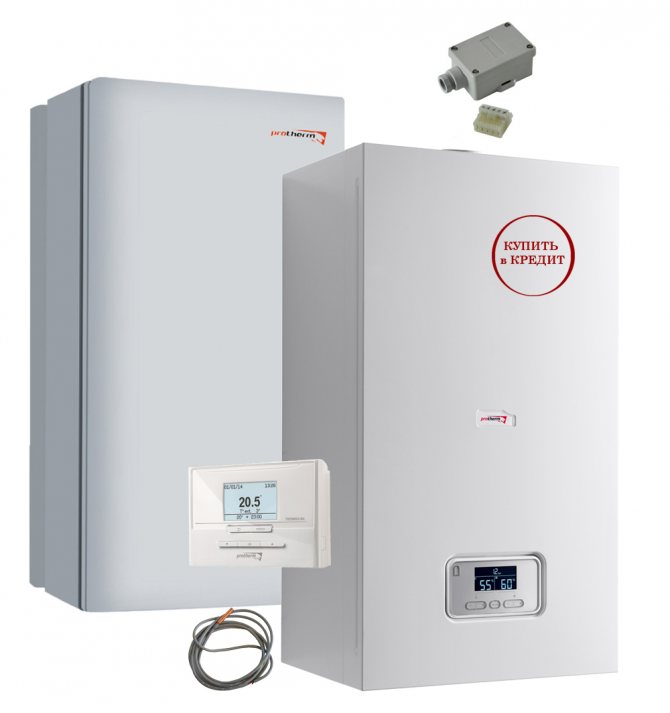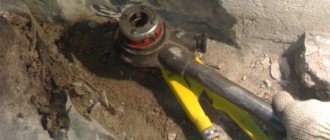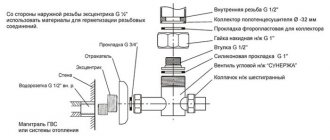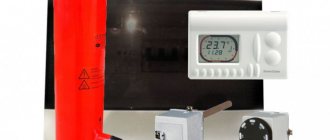Home / Gas boilers
Back to
Published: 14.06.2019
Reading time: 5 min
0
638
Heating with gas is considered the most affordable and efficient solution, since natural raw materials are cheap and have a high thermal potential.
To equip the heating system in the room, you can install a single-circuit wall-mounted gas boiler. Such a unit takes up little space and demonstrates good efficiency indicators.

- 1 Varieties 1.1 Differences by type of management
- 1.2 Type of ignition
- 2.1 Is it possible to make DHW with a single-circuit boiler
What are single-circuit wall-mounted gas boilers
A gas hinged single-circuit boiler is the central element of a local heating system, designed exclusively for heating rooms.


Single-circuit wall models have compact dimensions, stylish design and a minimum of communications around, they fit almost any interior (Vaillant EcoTEC model in the photo).
Among analogs, it stands out in its reduced size - from 55 to 90 cm in height and from 40 to 45 cm in width, as well as in weight - from 30 to 75 kg, which allows it to be mounted directly on the wall. Such a unit fits well into almost any environment, be it a pantry, a bathroom, a kitchen, an attic or even an attic.
The rated thermal power of wall-mounted gas boilers is significantly inferior to floor-standing ones: household - from 10 to 42 kW, industrial - from 46 to 100 kW. Nevertheless, this is quite enough for heating most of both residential and industrial facilities of an average area - from 60 to 800 m2.
If this is not enough, several compatible models can be cascaded to expand the power range - from 50 to 1000 kW.
Device and principle of operation
The wall-mounted boiler in many ways resembles a column, with the difference that it heats not running water, but a coolant circulating in a closed circuit.


The device of wall-mounted single-circuit models by the example of Buderus Logamax U072-24.
Each single-circuit boiler includes at least four working units:
- combustion chamber (firebox) equipped with a burner;
- plate-type primary heat exchanger;
- exhaust gas (smoke) removal system;
- mechanical / electronic control unit.
The exhaust of gases in the mounted models is carried out through a coaxial (side) chimney, usually it is already included in the basic kit. Modern units, in addition to these components, have a circulation pump, a built-in expansion tank, multifunctional automation, etc.
Regardless of the modifications, all gas boilers work according to the same scheme:
- The burner metered the air-gas mixture into the furnace for combustion.
- The released energy is transferred to the coolant through the heat exchanger.
- The circulating liquid (water, antifreeze) carries heat to the radiators.
- In the cooled state, it returns to the boiler - the cycle repeats again.
So, despite the compact case, single-circuit wall-mounted models "by default" have everything you need to connect to a common heating system. But in order to fully provide the house with hot water with their help, you will additionally need to install a storage water heater (boiler).
Organization of an autonomous hot water supply system (DHW)


An example of organizing a circuit using an indirect heating boiler.
An indirect heating boiler is a thermal tank that takes up part of the thermal energy from a third-party source to prepare hot water.
The peculiarity of wall-mounted boilers is that, for the most part, they are initially designed to work together with a boiler and have appropriate branch pipes for connecting it. Many models have special decorative panels, thanks to which one unit can be stacked on top of another without being attached to the wall.
The second circuit is connected in the standard way - parallel to the heating one, but in boilers with a boiler (as opposed to two-circuit analogs), the priority for DHW is given only during primary heating, and then the coolant is distributed so evenly that the change in heating power is invisible to the inhabitants of the house.
How to choose a room thermostat and save up to 30% per month on heating
Principle of operation
Single-circuit gas boilers with an indirect boiler operate in two main connection schemes. The principle of operation of the first is as follows:
- The three-way valve dominates here. A pump is installed directly into the outlet of the gas boiler, which circulates and builds up pressure. The next step is to install a three-way valve, which is connected to the boiler thermostat. When heating tap water or other coolant, its flow is directed to the heating system, and priority is given to the ingress of hot medium into the boiler coil. This is done using an additional, second pump. And it turns out that in this case the hot water supply and the heating system are connected in parallel, and they can form two circuits, in this closed chain. And after the boiler, an additional pump is installed, which helps to regulate the operation of the thermostat. The principle of starting and stopping the process is also controlled by a thermostat, namely, with strong heating, a forced shutdown of the fuel supply occurs, when the coolant cools down, the fuel is passed through again, and the burner is automatically ignited.
- If there is no double circuit and priority is not given to heating hot water, the boiler is mounted in a common system, installed in a convenient place, and the water is heated on a par with all radiators.
You will be interested >> The principle of operation of a single-circuit wall-mounted gas boiler
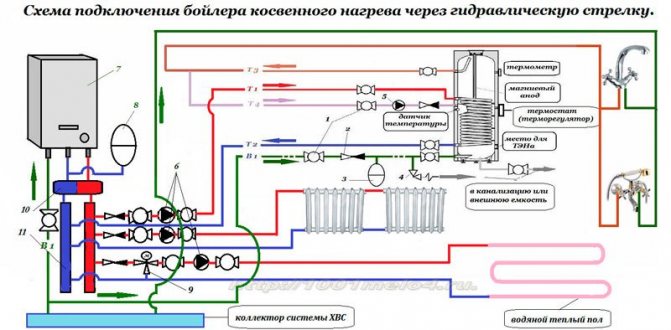

Reviews of the owners of mounted heating boilers: the main pros and cons
It's no secret that advertising articles and the opinions of consultants in the store can be biased, so you need to carefully study the experience of the real owners.
| Dignity | disadvantages |
| low cost - single-circuit wall models are considered the cheapest type of gas boiler | fragility - the unit is made of lightweight metals, therefore it is not designed for a long service for more than 15 years |
| reliability - unification of the technical component guarantees the absence of serious malfunctions and breakdowns. In practice, the number of calls to the service department of the owners of the mounted models is approximately equal to the number of calls to the owners of the floor speakers | complexity of service - compact assembly makes it difficult to access the units during routine inspection and repair |
| security - all mounted units are equipped to varying degrees with elements of automatic control and protection (against overheating, freezing of the system, stopping the circulation pump) | volatility - due to the presence of a circulation pump, complex automation, often - turbines, mounted models require connection to the mains. There are no non-volatile options today |
| free placement - such boilers can be installed in the vicinity of furniture and appliances, including stoves | |
| higher efficiency - despite the more compact dimensions, technologies, used alloys and more advanced automation allow to achieve an average of 2-5% higher efficiency in comparison with floor-standing counterparts |
Before installation, it is required to complete the accompanying documents and obtain permission from GazTechnadzor. It is also important to note that any gas boilers cannot be placed in corridors, bathrooms, basements, on balconies and in rooms without ventilation, when supplied with liquefied gas (LPG) - on basements.
Actual requirements for installing a gas boiler in a private house
CHOOSING A TWO-CIRCUIT BOILER
Criterias of choice.
Double-circuit models allow you to simultaneously provide a private house with both heat and hot water. When choosing this type of device, the following basic parameters are of decisive importance:
- installation method;
- combustion chamber type;
- material and type of heat exchanger;
- power.
Heat exchanger.
Since double-circuit installations heat water separately for water supply, and separately for heating, it is necessary to use special types of heat exchangers:
- double;
- bithermic.
The design of double heat exchangers consists of a modular pair - a primary module that heats the coolant, and a secondary one that heats water for domestic use.
Primary module
is a ribbed tube, the secondary is a set of plates. The modules are connected to each other, but they are located in different parts of the device: primary - from above, plate - from below.
Bithermal heat exchanger
consists of two metal tubes of different diameters, located one in the other. In the inner tube, the water is heated for hot water supply, in the outer tube - for the heating system.
The dual heat exchanger design is considered more reliable. Since the heating system is closed, the coolant constantly circulates in a circle, therefore scale practically does not form. When heating water for hot water supply, the situation is different - a lot of scale is formed.
Therefore, the element of the heat exchanger regularly requires repair or replacement. And if the double design allows for a separate replacement of the element heating water for domestic needs, then the bithermic one will have to be changed entirely.
When choosing a double-circuit boiler in a private house, the material of the heat exchanger should also be taken into account:
- Cink Steel;
- copper;
- stainless steel.
Galvanized steel is the simplest material, both cheap and short-lived.
Heaters with a copper heat exchanger have high efficiency, but their cost is also quite high. Most good gas boilers in private households are equipped with a copper heat exchanger, which can significantly reduce gas consumption.
Heat exchangers made of stainless steel are durable, but have low heat transfer, which reduces the efficiency of the device.
Combustion chamber type.
The combustion chamber in double-circuit gas installations, as in single-circuit ones, can be open and closed. There are no differences between these elements located in models of various types.
It should be noted that a gas installation with a closed-type combustion chamber heating a private house is more stable, since the air enters the combustion zone directly.
But when choosing, one should take into account a significant disadvantage of closed chambers: with a strong side wind, the incoming air flow can extinguish the burner, which will lead to the boiler shutdown.
Another disadvantage of a closed chamber can be called the operation of the boiler only when it is connected to the mains, otherwise the turbine will not work. And the third drawback is that the turbine is not at all silent.
It is for the above reasons, with a working ventilation duct, that many people prefer to install boilers with an open chamber in a private house. Largely also due to the fact that it is much easier to provide a constant air flow.
Boiler power.
If you take the selection of power responsibly, then you should determine the heat loss for each room of a private house or apartment. When performing calculations, it is necessary to take into account the characteristics of the materials and the thickness of the walls, the area of door and window openings, the presence of unheated rooms in the house, the type of roof and roof material.
Geographic location is also important.
The boiler output should be increased in the following cases:
- when erecting the walls, a material with high thermal conductivity was used (brick, concrete);
- large area of windows with leaking wooden frames;
- ceiling height exceeds 2.7 m;
- the presence of a poorly insulated or unheated attic.
Review of manufacturers.
After determining the required technical characteristics of a heating device for a private house, it remains only to decide with the manufacturer and choose a model that is suitable in all parameters.
There are three segments of gas heaters on the market:
- expensive;
- middle price range;
- cheap.
Expensive models include products from most European manufacturers: Italian Ariston, Ferroli and Beretta, German Vaillant and Viessmann.
The boilers of the middle price range include the Korean Navien, which are practically not inferior in quality and functionality to leading manufacturers.
Of the inexpensive boilers, the Russian brands Danko and Protherm should be noted, operating with a decrease in gas pressure, deviations in the power supply.
How to choose a gas wall-mounted single-circuit boiler for a private house


The range of wall-hung gas boilers for heating is very wide. To narrow down the search for the best option, it is absolutely not necessary to thoroughly understand all the nuances of the operation of the equipment - it is enough just to understand what this or that engineering solution gives in practice.
Convection, low temperature or condensing
The efficiency of a single-circuit hinged gas boiler depends on the method of use of the thermal energy released during the combustion of fuel. On this basis, all units are classified into three groups:
- convection - standard models that receive energy only from direct combustion of gas, while they constantly heat the coolant to high (70-80 ° C) temperatures, regardless of how much heat is needed at the moment, so most of it remains unclaimed and goes away along with the hot (130–160 ° C) smoke;
- low temperature - have the same design as traditional boilers, but they eliminate contact between the cold walls of convective pipes (by shielding) and exhaust combustion products (100–120 ° C), therefore, water cooling is allowed in them (20–40 ° C) , without the risk of condensation;
- condensing - work best when the water temperature in the heating system is below the "dew point" of the gas (10-50 ° C), they are equipped with an auxiliary heat exchanger (economizer), which accumulates the heat of water vapor, not allowing it to come out with smoke, which is why the latter cools down (70–80 ° C).


The principle of operation of conventional convection (efficiency 88-92%) and condensing (efficiency 104-116%) gas boilers.
It is clear that newer models are more expensive than the usual convection ones, but their operation is more profitable: low-temperature boilers are on average 15–20% more economical, and condensing boilers are 25–40% more economical. In addition, the colder the exhaust smoke, the less harmful the unit itself has on the environment.
Differences and selection criteria for condensing gas boilers
Primary (high temperature) heat exchanger material
The primary (high temperature) heat exchanger performs the function of transferring heat from the burner to the heating medium. All wall-mounted boilers are equipped with heat exchangers made of thin and light metals - steel (enameled, stainless) and copper. But the popular durable cast iron is too heavy for this type of equipment.
Conventional heat exchangers are not used to collect steam: it, mixing with smoke, turns into acid and corrodes the walls. Therefore, in condensing boilers, the second (cold) heat exchanger is made of a metal resistant to the aggressive effects of acids, for example, silumin, an aluminum-silicon alloy.
There is no definite answer which heat exchanger is more suitable for the boiler: it all depends on the quality of the metal, its thickness, processing method, etc.
With copper heat exchanger


Copper is considered the most suitable material for wall-hung boilers - it is lightweight, ductile and corrosion-resistant (does not rust). Due to the low inertia, copper heat exchangers quickly warm up, but if they are used for a long time under conditions of intense heating, they can start to burn out.
Thus, boilers with a copper heat exchanger have more advantages than disadvantages, but due to the relative high cost, they can often be found in imported models, while domestic manufacturers prefer to make their heat exchangers from more democratic steel. The service life of copper heat exchangers is 14-16 years.
With steel heat exchanger


Steel is more resistant to influences of both thermal and physical nature, for example, pressure surges and shocks during transportation. Heat exchangers made of it are easy to manufacture, which, not least of all, determines the final, lower price of the unit.
At the same time, the efficiency of steel heat exchangers is lower, because a considerable part of the energy is given simply to warm up the walls. They are more susceptible to corrosion, their service life is often no more than 12-14 years. To extend it, manufacturers go for a trick: they cover the steel with copper, and on top they apply a layer of durable heat-resistant enamel.
Combustion chamber type and exhaust gas removal system


The operation of all boiler units is accompanied by the supply of the required volume of air to the furnace and the subsequent disposal of waste flue products.
In gas units, these processes are carried out in two ways:
- atmospheric model - equipped with an open combustion chamber, air intake and smoke removal is carried out through vertical channels (natural draft);
- turbocharged model - has a closed combustion chamber, air intake and smoke removal is due to a powerful fan (forced draft).
Open combustion chamber and natural draft
The atmospheric gas boiler with an open combustion chamber is a classic unit that consumes oxygen from the room in which it is located. Therefore, the first - to maintain stable operation, it will be necessary to regularly ventilate the room or install a ventilation system in it.
Of the positive aspects, it is worth highlighting its budgetary cost and silent operation: you can only hear the flame "buzzing" and water flows.
Closed combustion chamber and forced draft (coaxial chimney)
More advanced models, accounting for over 90% of the market. A turbocharged boiler with a closed combustion chamber has a different principle of operation: it absorbs oxygen from the street, through a coaxial chimney (outer pipe), and smoke through it (inner pipe) is removed to the outside - this completely excludes air intake from the room, which allows you not to worry about ventilation.
This design guarantees the impossibility of fuel leakage and other emergencies, since in it the combustion chamber is separated from the room and connected only to the chimney itself, and the sealed casing does not allow the heated parts to come into contact with the gas. Cons - additional noise from the fan.
Most forced draft units have a closed combustion chamber, while those with natural draft have an open one. But there are exceptions. So, among the boilers with an open combustion chamber, there are unusual models from the Japanese company Rinnai, which are equipped with a fan at the inlet to remove exhaust smoke.
Varieties of gas burners according to the degree of flame regulation
A gas burner is the "heart" of any gas boiler: it is she who is responsible for igniting and maintaining the process of fuel combustion, regulating its intensity. In total, according to the degree of flame regulation, there are three types of burners:
- single stage - always work in one position at 100% power, maintain the coolant temperature at a fixed level due to periodic switching on and off.
- two-stage - they operate in two modes at 30/50% (depending on the model) and at 100% power, they are powered by electric ignition and never turn off, therefore, when the water temperature reaches the set value, the boiler switches to economic mode (until partial cooling) ;
- modulated - precisely adjust the desired power by 10–100%, their operation is controlled by sophisticated microprocessor automation, while the modes change, depending on the current parameters of the heating system: changes in pressure in the main pipeline, coolant temperature and others.
The most efficient and economical are simulated burners. They automatically select the optimal amount of fuel (including liquefied fuel) and smoothly regulate the heating of the coolant - this helps not only to reduce gas consumption, but also to ensure a minimum percentage of empty undercooling.


An example of the operation of a modulating burner. The ideal mode of operation is always considered to be continuous combustion at the lowest possible power.
Coefficient of performance (COP)
It is believed that the higher the efficiency indicator, the more efficient the operation of the boiler and, accordingly, it consumes gas more economically, however, in the case of wall-mounted models, this is not entirely true. For modern units, the real efficiency has long been approximately at the same level: standard 91–95%, condensing 103–109%. However, a difference of a few percent in efficiency still cannot be the main selection criterion, especially when heating small houses up to 100 m2.
In this regard, it is better to focus not on its efficiency, but on the estimated fuel consumption, which the manufacturer indicates in the technical passport. For domestic boilers 10–20 kW, the optimal maximum flow rate is 0.9–2.1 m3 of natural gas or 0.7–1.9 kg of LPG per hour.
Minimum required power
The required power can be calculated using a simplified formula:
Q = S × 0.1where
- Q - required power (kW),
- S - area of the heated dwelling (m2),
- 0,1 - the rate of power per unit area for an average house with 2 brick masonry and a ceiling height of 2.7 meters, located in the climatic zone of the Moscow region.
For example, for a residential building of 120 m², Q = 120 × 0.1 = 12 kW, we also recommend making a reserve of 15–20% for possible frosts, therefore for the same object Q≈14 kW.
When installing an indirect heating boiler, you must immediately take into account that its energy demand should not exceed 45-50% of the total boiler power.
How to accurately calculate the required boiler power Individual calculation, formula and correction factors
Additional criteria
In addition to the listed differences, you can consider other parameters that affect the comfort and safety of operation:
- automation functionality - ideally, the control module controls all processes by itself, from starting and changing modes to blocking in the event of a breakdown;
- security level - each sold boiler a priori complies with the standards, but some have a more complex multi-stage protection system;
- degree of heat and sound insulation - dense casing prevents heat loss (increases the efficiency of the device), and also reduces noise from the fan and burner;
- the possibility of using antifreeze - for filling chemical. Only special aggregates resistant to aggressive effects are suitable for use with substances.
Turbocharged and atmospheric units
Single-circuit wall-mounted gas boilers are built according to schemes with open and closed combustion chambers.The first scheme is the most widespread - traditional gas burners are used here, which are distinguished by their simplicity of design. The flame in such burners burns with a natural flow of fresh air, and the combustion products are removed through a classic chimney. The advantages of the scheme:


The strength of the flame in an atmospheric burner depends only on the pressure in the gas line. However, such a burner works absolutely silently.
- Simplicity - the fewer parts, the less breakdowns (provided that you choose a proven model from a reputable manufacturer);
- Low noise level - only the flame and the circulation pump (if any) are buzzing here;
- More affordable cost compared to turbocharged units.
Among the disadvantages are the need for good ventilation, not the highest efficiency, not always efficient combustion of fuel, the need for a full-fledged chimney that goes to the roof.
Turbocharged single-circuit wall-mounted gas boilers are more advanced heating units built on the basis of closed combustion chambers. The gas in them burns in chambers with forced removal of combustion products and forced supply of fresh air. For this, the chambers are equipped with variable speed fans. Such a scheme allows you to get rid of the traditional chimney and the need to place the boiler in a room with good ventilation.
For the operation of a turbocharged wall-mounted single-circuit gas boiler, a special chimney is needed, which is simply displayed behind the nearest wall. Such a chimney is called coaxial, it consists of two pipes inserted into one another. Atmospheric air is sucked in through one pipe, combustion products are removed through the other. There is no need to build a traditional chimney.
Turbocharged single-circuit wall-mounted boilers are optimal for installation in buildings where there was previously no gas main and there is no conventional chimney for installing a boiler with an open combustion chamber.
The best known manufacturers and models: characteristics and prices
BAXI ECO Four 1.24


The famous Italian boiler with an open combustion chamber from the popular BAXI ECO line, stands out for its special reliability and durability (even among other European models) at an extremely affordable price.
Its hydraulic unit is equipped with a pressure gauge, an automatic bypass and a heating medium filter, and the integrated control unit has weather-compensated regulation and self-diagnostic options. With a power of 24 kW, it consumes 2.7 m3 / h (LPG 2.0 kg / h). The primary heat exchanger is made of copper.
Cost: 32 210 - 35 750 rubles.
Protherm Panther 25 KTO


This model belongs to the equipment of the middle class (increased comfort) - it is convenient both in connection and in everyday use.
The turbocharged unit has a closed combustion chamber. The heat exchanger, internal wiring and inlet / outlet pipes are made of copper. The burner with a modulation depth of up to 25 kW burns 2.8 m3 / h (LPG 2.1 kg / h) of gas at the maximum capacity.
Cost: 43 150 - 47 620 rubles.
Vaillant turbo TEC plus VU 242 5-5


This 24 kW German reference gas boiler has long been recognized by the craftsmen as the leader among all turbocharged units in terms of reliability and build quality.
German models are always distinguished by extreme reliability and resistance to any operating conditions, which is ensured by the use of modern alloys and technologies. It has an alphanumeric display with an extended list of information codes, a circulation pump with auto-switching, a copper heat exchanger and a burner made of chromium-nickel steel, which is not subject to burnout. Maximum fuel consumption 2.9 m3 / h (LPG 2.2 kg / h).
The only drawback is vulnerability to voltage surges (it is advisable to connect to the network through a stabilizer).
Cost: 54 920 - 59 670 rubles.
The best German gas boilers The most efficient, reliable and functional models on the market
Viessmann Vitopend 100-W A1HB002


Another reference German representative, the low-temperature unit is one of the best gas wall-mounted single-circuit boilers for heating a private house, especially popular in the EU.
It has a copper heat exchanger and a “smart” controller with a self-tuning function, which protects the automation system from fluctuations in the gas and electric network. This allows him to adapt to the most extreme situations. For a power of 30 kW, it is quite economical - 3.4 m3 / h (LPG 2.5 kg / h).
According to the practice of operation and feedback from the owners, all models have been working without problems for more than 6 years.
Cost: 39 650 - 46 180 rubles.
Buderus Logamax U072-18


An inexpensive 18 kW unit with a copper heat exchanger was designed specifically for operation in typical Russian conditions, including freezing.
Its advantage is low price, excellent design and economy. The Buderus service structure is highly developed in Russia and is known for the presence of competent specialists in almost all regions. The maximum consumption is 2.0 m3 / h (LPG 2.8 kg / h) of fuel.
Cost: 28 250 - 36 180 rubles.
Rinnai BR-UE30


The well-known Japanese model, despite its ultra-compact size, has a rather impressive power of 29 kW. It also has a copper heat exchanger.
As in all Asian boilers, it pays special attention to the comfort of the owner, so it includes a set of side modules: a voice navigator, remote access (remote control, Wi-Fi) and weather-dependent automation. Precise temperature control helps to minimize gas consumption - 2.8 m3 / h (LPG 2.5 kg / h).
Cost: 55 300 - 61 900 rubles.
Features of gas single-circuit boilers for heating a private house
When choosing a single-circuit boiler for a home, you should remember that its main purpose is heating. Such a unit is able to provide a home with hot water only if an external indirect heating boiler is connected. The latter is purchased separately, and its choice is based on meeting the needs of all residents.
Important! If we compare the bundle "single-circuit heat generator - boiler" with double-circuit devices, it will cost more. On the other hand, such a tandem is able to provide several taps with hot water at the same time, although it heats the water more slowly.
It should be noted that the cost of models with one heating circuit without additional equipment, when compared with two-circuit options, is lower.
A gas single-circuit boiler has a number of advantages, which is why its use despite for more technically advanced double-circuit models, continues to be relevant:
- Easy to customize for any user request.
- Possibility of using several devices in a cascade connection.
- Relatively simple construction, from which the next point follows.
- Reliability.
- Availability.
There is an opinion that in terms of reliability, a single-circuit boiler is ahead of a double-circuit boiler, since it has trite fewer structural elements, and therefore a lower chance of breakdown. This is partly true, especially considering that the load on models with two contours is higher.
But even the best boiler in all the declared characteristics can fail if its components are made of low quality materials.
Prices: summary table
Comparative rating of wall-mounted single-circuit gas boilers:
| Boiler name | Efficiency,% | power, kWt | Gas consumption, m3 / h | price, rub. |
| BAXI ECO Four 1.24 | 91,2 | 24 | 2,7–2,0 | 34 000 |
| Protherm Panther 25 KTO | 92,8 | 25 | 2,8–2,1 | 45 000 |
| Vaillant TEC VU 242 5-5 | 91,9 | 24 | 2,9–2,2 | 57 500 |
| Viessmann Vitopend 100 W | 93,0 | 30 | 3,4–2,5 | 43 000 |
| Buderus Logamax U072-18 | 92,1 | 18 | 2,0–2,8 | 32 000 |
| Rinnai BR-UE30 | 92,8 | 29 | 2,7–2,5 | 58 500 |





